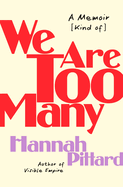
In We Are Too Many, novelist Hannah Pittard (Reunion; Listen to Me; Visible Empire) examines her failed marriage, which cratered with the revelation that her husband, Patrick, was having an affair with her best friend, Trish. In her semi-experimental three-part account, Pittard performs a kind of exploratory character surgery using unorthodox tools and no anesthesia. The experience is squirm-making, seems a little sordid, and is often thrilling.
Part One is written like a play: each segment begins with its time and place, followed by an admittedly "imperfectly recollected" dialogue. Typically, the conversations involve Pittard and Patrick as they navigate 10 years together, largely in Lexington, Ky., and Charlottesville, Va. It can be tempting to read this part of the book as score settling gussied up as a literary concern, as the dialogues routinely show Patrick in an appalling light. But Part Two, a fantasy two-hander in which Pittard and Patrick have it out, redresses the imbalance by frequently showing her in an unfavorable light. Here the anger of the book's first part sloughs off and exposes a wound: "I guess what I'm trying to figure out is, whose fault is it?" Pittard says to Patrick at one point.
Part Three offers autobiography in short chapters that rehash the aftermath of Patrick's affair: he's now married to Trish, and Pittard has a new boyfriend. This is the most straight-up of the book's three parts, which could be summarized as, respectively, rage, hurt, and healing. Cumulatively, the parts of We Are Too Many tell the story of heartbreak in perhaps the most scorching, gutting, and tantalizing way imaginable. --Nell Beram, author and freelance writer

